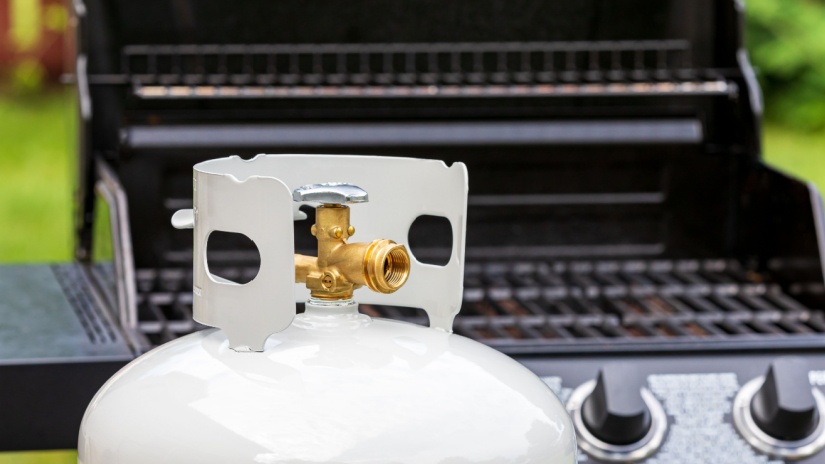Knowledge Centre
Gas in Australia: What is propane gas?

We’ve all spent time waiting at the petrol station while someone fills up their vehicle, and we've all noticed a stack of grey cylinders neatly stored in a cage nearby. For some households, propane is a regular part of life, but for others, it remains a bit of a mystery when they don't use it for anything.
Whether you’re a seasoned propane user or just starting to explore this versatile fuel, there’s plenty to learn. At Compare Energy, we’re here to help you understand LPG propane better. We’ll cover everything from how propane works to its benefits and how it can be used in your home.
What is propane gas?
Propane is a type of gas used in Australia for various applications, including heating, cooking, and powering appliances in homes and businesses. Unlike being created specifically for these uses, propane is actually a byproduct of processing natural gas and refining crude oil.
In its natural state, propane is a colourless, odourless gas. However, for safety reasons, an odorant called ethyl mercaptan is added to the propane when it is bottled. This ensures that if there is ever a gas leak, the distinctive smell makes it easier to detect and address the issue quickly.
Propane is stored in its liquid form in gas bottles or tanks until needed. When released, it turns into a gas as it evaporates. It’s important to note that, like other liquids, propane expands and contracts with temperature changes. For instance, on hot days, the propane in your bottle will expand.
To manage this, Australian standards require that propane bottles are not filled completely to prevent over-pressurisation. This safety measure helps ensure the safe use and handling of propane throughout its storage and application.
Is LPG the same thing?
Propane and LPG (Liquefied Petroleum Gas) are terms that are often used interchangeably, but they refer to different aspects of the same fuel type. Here's a clear breakdown of their differences:
Propane
- Propane is a specific type of hydrocarbon gas, chemically known as C₃H₈. It is one of the components of LPG but can also be used independently.
- At room temperature and atmospheric pressure, propane is a gas. When compressed, it turns into a liquid and is stored in cylinders or tanks.
- Propane is commonly used for heating, cooking, hot water, and as fuel for vehicles (Autogas). It is also widely used in outdoor activities like camping and boating.
- Propane has a boiling point of -42°C, which means it remains a gas in most temperatures but can easily be liquefied under moderate pressure.
LPG (Liquefied Petroleum Gas)
- LPG is a broad term that encompasses a mix of hydrocarbon gases, primarily propane and butane (C₄H₁₀), but can also include other hydrocarbons like propylene. It is named for its ability to be liquefied under moderate pressure.
- LPG can exist as a mixture of gases that liquefy when compressed. It is stored and transported in its liquid form but used as a gas.
- LPG is used in similar applications as propane, including heating, cooking, and fuel for vehicles. It can also be used in industrial processes and for agricultural purposes. The specific mix of gases in LPG can vary based on regional preferences and requirements.
- Its composition varies, but it generally includes a combination of propane and butane. The ratio of propane to butane can influence its suitability for different uses. For example, a higher propane content is preferred for colder climates because propane has a lower boiling point.
While propane is a type of LPG, LPG itself refers to a mixture of gases that includes propane and butane. Understanding these differences can help in choosing the right fuel for specific needs and applications.
Uses for propane gas
Propane is an incredibly versatile fuel with a wide range of applications beyond typical household use.
While many Australians primarily rely on propane for heating, cooking, hot water, and drying clothes, its uses extend far beyond the home. Here are several other ways propane is used:
| Activity | How it's used |
| Camping and caravanning | Propane is commonly used for portable stoves, heaters, and lanterns, making it a staple for camping trips and caravanning adventures.
|
| Boating | Many boats use propane for cooking and heating, ensuring comfort while at sea. |
| Recreational vehicles (RVs) | Propane powers appliances such as refrigerators, stoves, and heaters in RVs, allowing for a comfortable and self-sufficient travel experience. |
| Powering equipment | Propane is used to fuel steam boilers, kilns, and industrial ovens, playing a crucial role in various manufacturing processes. |
| Heating | It is also used in industrial heating applications to maintain optimal temperatures in production facilities. |
| Forklifts | Propane-powered forklifts are common on construction sites due to their efficiency and lower emissions compared to diesel models. |
| Portable generators | Propane is a popular choice for portable generators used on construction sites to provide reliable power. |
| Temporary heaters | Propane-powered heaters offer a convenient solution for warming construction sites during colder months. |
| Crop and produce drying | Propane is used to fuel dryers for crops and produce, helping to preserve and prepare agricultural products. |
| Heating greenhouses | It provides a consistent heat source for greenhouses, promoting optimal growing conditions for plants. |
| Irrigation pumps | Propane powered irrigation pumps, ensuring efficient water delivery to crops. |
| Autogas | Propane is used as a fuel for Autogas vehicles, offering an alternative to traditional gasoline and diesel fuels. It is known for its lower emissions and cost-effectiveness. |
| Cooking appliances | Propane fuels commercial kitchen appliances, including stoves, ovens, and grills in restaurants and cafes. |
| Outdoor lighting | Propane is also used for outdoor lighting, creating ambience in restaurants, hotels, and event spaces. |
These diverse applications highlight propane's adaptability and efficiency across various sectors, from everyday leisure activities to critical industrial processes.
Why choose propane?
Propane offers several advantages over other energy sources. Here are three compelling reasons to consider using propane:
Amazing performance in cooking
Propane provides excellent cooking efficiency. When used on a stovetop, propane delivers intense heat quickly, outperforming electric cooktops in both heating speed and control.
With propane, you can achieve instant heat adjustments, making it easier to regulate cooking temperatures.
Unlike electric cooktops, which require time for heating elements to warm up or cool down, propane allows for precise and immediate changes in heat levels.
It’s environmentally friendly
For those looking to reduce their environmental impact, propane is a cleaner choice. Propane is not classified as a greenhouse gas, unlike methane, and burns more cleanly compared to natural gas.
It produces lower emissions of carbon dioxide (CO2) compared to coal, which is often used to generate electricity. This makes propane an eco-friendlier option, contributing to a smaller carbon footprint and a cleaner environment.
Offers high efficiency and convenience
Propane is a highly efficient and versatile energy source. It is supplied in portable gas cylinders, making it easy to store and transport.
This is especially beneficial for households in regional areas of Australia that lack access to natural gas mains.
Propane's portability ensures that even in remote locations, you can have a reliable and efficient energy source for cooking, heating, and other applications.
Is propane the same as natural gas?
Propane is not the same as natural gas, although both are used as fuel sources. Here’s a breakdown of their differences:
Composition
| Propane | Chemically known as C₃H₈, propane is a hydrocarbon that is a byproduct of natural gas processing and crude oil refining. It is a distinct chemical compound. |
| Natural gas | Primarily composed of methane (CH₄), natural gas is a fossil fuel found in underground deposits. It may also contain small amounts of other hydrocarbons, such as ethane, propane, and butane, but methane is the dominant component. |
State and storage
| Propane | At room temperature and atmospheric pressure, propane is a gas. However, it is stored as a liquid in pressurised tanks or cylinders. When released from the tank, it evaporates into a gas. |
| Natural gas | Natural gas is typically distributed as a gas through pipelines. It is stored in its gaseous form at relatively low pressure, or in liquefied form (LNG) for transportation over long distances. |
Energy content and usage
| Propane | Propane has a higher energy content per unit volume compared to natural gas. It is often used in areas without natural gas infrastructure, for applications such as heating, cooking, and powering certain vehicles (Autogas). |
| Natural gas | It is used for residential heating, cooking, and in power generation. It is distributed via pipelines and is commonly used in urban areas with established gas infrastructure. |
Environmental impact
| Propane | Propane burns cleaner than some fossil fuels and produces fewer greenhouse gases and pollutants compared to coal and oil. However, it still releases CO₂ when burned. |
| Natural gas | While natural gas is cleaner than coal and oil, it is still a fossil fuel and emits CO₂ when combusted. Methane, the main component, is also a potent greenhouse gas if released into the atmosphere unburned. |
Odour
| Propane | Naturally odourless, propane has an added odorant called ethyl mercaptan to make leaks detectable by smell. |
| Natural gas | Also naturally odourless, natural gas is similarly treated with an odorant (typically mercaptan) for leak detection. |
While both propane and natural gas are used for similar purposes, they differ significantly in composition, storage methods, energy content, and environmental impact.
Which is more affordable?
Typically, natural gas is less expensive per unit compared to propane (LPG). However, when factoring in additional costs, the overall expense might be comparable.
Natural gas customers often incur an annual supply charge ranging from $300 to $400, which can impact the total cost. On the other hand, propane users also face a service charge, but this is generally lower, usually between $40 and $50 per year.
Compare with Compare Energy
It's important to note that gas prices and rates fluctuate frequently. To ensure you’re getting the best deal, it's wise to regularly compare offers and review current rates and the best thing to do is to call Compare Energy on 1300 790 106.
At Compare Energy, we can talk to you about the best gas options for your energy bills, so you get the best deal. Our Aussie-based team is here and ready to talk to you.

